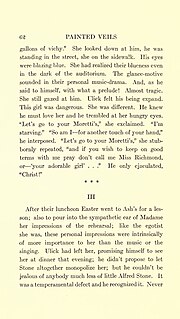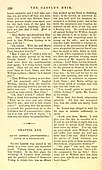
In typography, a dinkus is a typographic symbol which often consists of three spaced asterisks or bullets in a horizontal row, i.e. ∗ ∗ ∗ or • • • . The symbol has a variety of uses, and it usually denotes an intentional omission or a logical "break" of varying degree in a written work. This latter use is similar to a subsection, and it indicates to the reader that the subsequent text should be re-contextualized. When used this way, the dinkus typically appears centrally aligned on a line of its own with vertical spacing before and after the symbol. The dinkus has been in use in various forms since c. 1850. Historically, the dinkus was often represented as an asterism, ⁂, though this use has fallen out of favor and is now nearly obsolete.
Etymology
The word was coined by an artist on the Australian periodical, The Bulletin, in the 1920s and is derived from the word dinky.
Usage
The dinkus is used for various purposes, but many of them are related to an intentional break in the flow of the text.
Subsection break
A dinkus can be used to accentuate a break between subsections of a single overarching section. When an author chooses to use a dinkus to divide a larger section, the intent is to maintain an overall sense of continuity within the overall chapter or section while changing elements of the setting or timeline. For instance, when the writer is introducing a flashback or other jarring scene change, a dinkus can help denote the change in setting within the overall theme of the chapter; in that case, it can be preferable to the initiation of a new chapter. This technique is used especially in literary fiction.
Intentionally omitted information
See also: EllipsisMany applications of the dinkus, including those that were common historically, have indicated intentional omission of information. In these cases, the dinkus is used to inform the reader that the information has been omitted. It can also be used to mean "untitled" or that the author or title was withheld. This is evident, for example, in some editions of Album for the Young by composer Robert Schumann (№ 21, 26, and 30).
A dinkus can also be used in any context as a simple means of abbreviation of any text. The dinkus is also used specifically in this capacity within the sphere of lawmaking, particularly for city ordinances. When used in legal text, the dinkus indicates an abbreviation within amendments to code while not implying the repeal of the omitted sections.
Ornamentation
Newspapers, magazines, and other works can use dinkuses as simple ornamentation of typography, for solely aesthetic reasons. When a dinkus is used primarily for aesthetic purposes, it often takes the form of a fleuron, e.g. ❧, or sometimes a dingbat. While fleurons, dingbats, and dinkuses are usually distinct, their uses can overlap.
Poetic symbolism
In some cases, the use of a dinkus has been employed in poetry in order to convey non-verbal meaning. This is exemplified in the poem Thresholes by Lara Mimosa Montes, in which the poet makes frequent use of a circular dinkus, ○ , as a form of "punctuation at the level of the full text, rather than the phrase or the sentence" throughout the course of the work.
Variations
Many variations of dinkuses are composed partially or entirely of asterisks, although other symbols can be used to achieve the same goals. Some examples include a series of dots, fleurons, asterisms, or small drawings. Esperanto Braille punctuation commonly uses a series of colons, ⠒⠒⠒, as a dinkus.
Gallery
Uses of dinkuses in literary works-
 A Polish translation of a French work depicting the use of a series of dots as a dinkus. The dinkus is used to separate the translator's notes from the text.
A Polish translation of a French work depicting the use of a series of dots as a dinkus. The dinkus is used to separate the translator's notes from the text.
-
 A combination of a fleuron and line-shaped dinkus in the same Polish work.
A combination of a fleuron and line-shaped dinkus in the same Polish work.
-
 Mrs. Henry Wood's 19th century novel exemplifying a line shaped dinkus with a central diamond used as a chapter break.
Mrs. Henry Wood's 19th century novel exemplifying a line shaped dinkus with a central diamond used as a chapter break.
-
 Photograph of a German novel, Infinite Adventures, which uses an infinity symbol in triplicate as a dinkus.
Photograph of a German novel, Infinite Adventures, which uses an infinity symbol in triplicate as a dinkus.
-
 Lewis Carroll's Alice in Wonderland, in a print of indeterminate age, features dinkuses in the form of asterisks used to form a field of stars.
Lewis Carroll's Alice in Wonderland, in a print of indeterminate age, features dinkuses in the form of asterisks used to form a field of stars.
-
 Ulysses by James Joyce uses an asterism as a dinkus in earlier prints, while newer editions replace it with three horizontal asterisks.
Ulysses by James Joyce uses an asterism as a dinkus in earlier prints, while newer editions replace it with three horizontal asterisks.
Other uses of the term "dinkus"
See also: Śmigus-dyngusAmong older Hungarian Americans and Polish Americans, dinkus is an archaic term for Easter Monday.
In Australian English, particularly in the news media, the word "dinkus" refers to a small photograph of the author of a news article. Outside of Australia, this is often referred to as a headshot.
References
- ^ Butterford, Consul Willshire (1858). A Comprehensive System of Grammatical and Rhetorical Punctuation. Cincinnati: Longley Brothers. pp. 37, 40.
- ^ Houston, Keith (2013). Shady Characters: The Secret Life of Punctuation, Symbols, and Other Typographical Marks.
- Peško, Radim; Lüthi, Louis (2007). Bailey, Stuart; Bilak, Peter (eds.). Dot Dot Dot 13. Princeton Architectural Press. p. 193. ISBN 978-90-77620-07-6.
- ^ "Dinkus". Macquarie Dictionary. Sydney.
A dinkus is a small drawing used in printing to decorate a page, or to break up a block of type. It was coined by an artist on The Bulletin magazine in the 1920s, and it is derived from the word dinky, meaning 'small'
- "Glossary". The News Manual.
- Hudson, Robert (2010). The Christian Writer's Manual of Style. p. 386.
- "D'Alliage à Avertissement — Orthotypographie, de Jean-Pierre Lacroux (Lexique des règles typographiques françaises)". www-orthotypographie-fr.translate.goog.
- ^ Flann, Elizabeth; Hill, Beryl; Wang, Lan (2014). The Australian Editing Handbook.
- ^ Lacroux, Jean-Pierre. Orthotypographie.
- ^ "Five Ways I Hate Your Dinkus". Self-Publishing Review. August 26, 2021.
- Taruskin, Richard (2005). The Oxford History of Western Music. Vol. 3. p. 311. ISBN 978-0-19-516979-9.
- "Did You Know? The Dinkus". Municode.
- Quinn, Stephen (2012). Digital Sub-Editing and Design.
- Bringhurst, Robert (2004). The Elements of Typographic Style (3rd ed.). Hartley & Marks. p. 63, 290–291. ISBN 978-0-88179-206-5. Retrieved 10 November 2020.
- Gabbert, Elisa (December 29, 2020). "How Poets Use Punctuation as a Superpower and a Secret Weapon". The New York Times.
- Lundmark, Torbjorn (2002). Quirky Qwerty: The Story of the Keyboard @ Your Fingertips. University of New South Wales. p. 120. ISBN 9780868404363.
- ^ Crystal, David (2016). Making a Point: The Pernickety Story of English Punctuation. London Profile Books. ISBN 9781781253519.
- Pleck, Elizabeth Hafkin (2001). Celebrating the Family: Ethnicity, Consumer Culture, and Family Rituals. Harvard University Press. p. 90. ISBN 9780674002302.
- "Infinite Anthology". The Monthly. August 5, 2010.
- Sadokierski, Zoe (27 March 2014). "Why The Saturday Paper's design breeds disappointment". The Conversation.
Further reading
- Daisy Alioto's analysis of the dinkus in The Paris Review: Ode to the Dinkus.
| Common punctuation and other typographical symbols | |
|---|---|
| |
| |
| |
| |